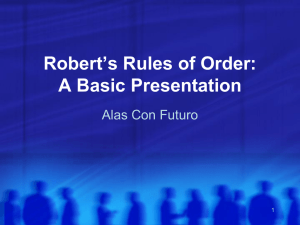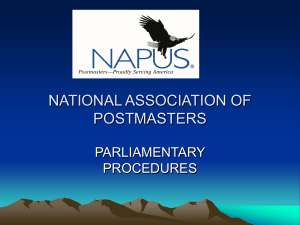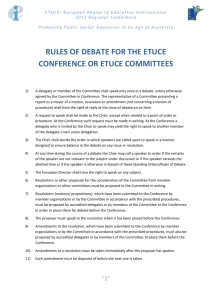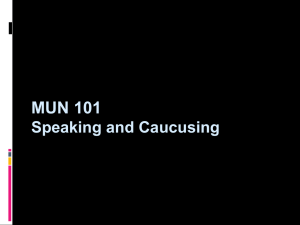File - Walker Model Congress
advertisement
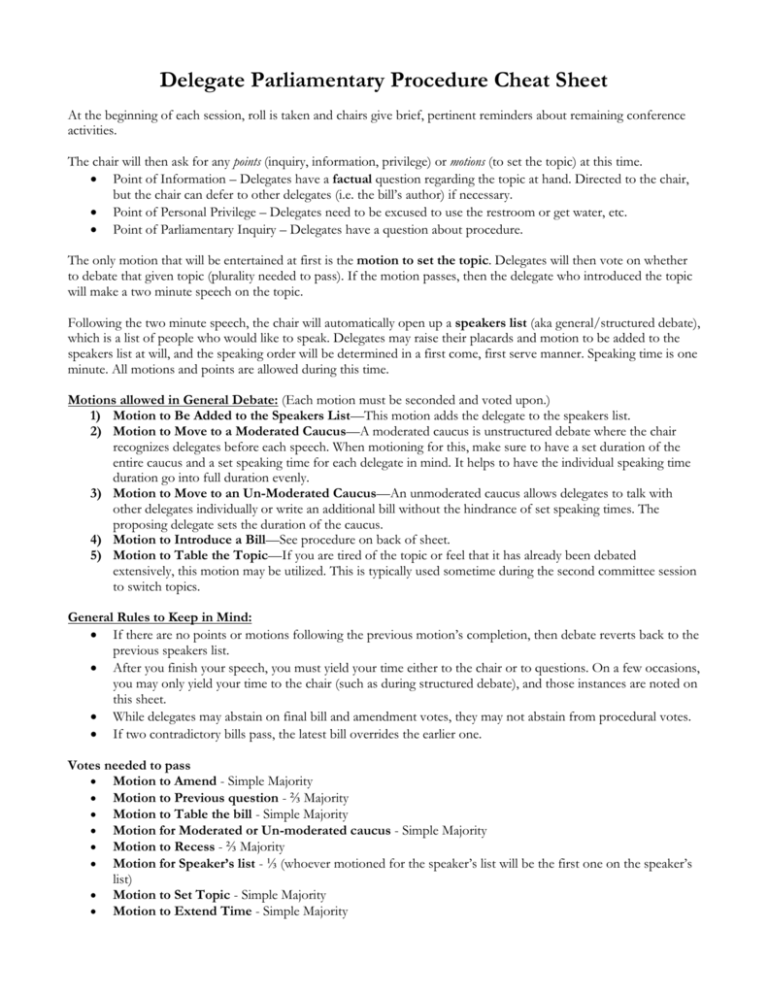
Delegate Parliamentary Procedure Cheat Sheet At the beginning of each session, roll is taken and chairs give brief, pertinent reminders about remaining conference activities. The chair will then ask for any points (inquiry, information, privilege) or motions (to set the topic) at this time. Point of Information – Delegates have a factual question regarding the topic at hand. Directed to the chair, but the chair can defer to other delegates (i.e. the bill’s author) if necessary. Point of Personal Privilege – Delegates need to be excused to use the restroom or get water, etc. Point of Parliamentary Inquiry – Delegates have a question about procedure. The only motion that will be entertained at first is the motion to set the topic. Delegates will then vote on whether to debate that given topic (plurality needed to pass). If the motion passes, then the delegate who introduced the topic will make a two minute speech on the topic. Following the two minute speech, the chair will automatically open up a speakers list (aka general/structured debate), which is a list of people who would like to speak. Delegates may raise their placards and motion to be added to the speakers list at will, and the speaking order will be determined in a first come, first serve manner. Speaking time is one minute. All motions and points are allowed during this time. Motions allowed in General Debate: (Each motion must be seconded and voted upon.) 1) Motion to Be Added to the Speakers List—This motion adds the delegate to the speakers list. 2) Motion to Move to a Moderated Caucus—A moderated caucus is unstructured debate where the chair recognizes delegates before each speech. When motioning for this, make sure to have a set duration of the entire caucus and a set speaking time for each delegate in mind. It helps to have the individual speaking time duration go into full duration evenly. 3) Motion to Move to an Un-Moderated Caucus—An unmoderated caucus allows delegates to talk with other delegates individually or write an additional bill without the hindrance of set speaking times. The proposing delegate sets the duration of the caucus. 4) Motion to Introduce a Bill—See procedure on back of sheet. 5) Motion to Table the Topic—If you are tired of the topic or feel that it has already been debated extensively, this motion may be utilized. This is typically used sometime during the second committee session to switch topics. General Rules to Keep in Mind: If there are no points or motions following the previous motion’s completion, then debate reverts back to the previous speakers list. After you finish your speech, you must yield your time either to the chair or to questions. On a few occasions, you may only yield your time to the chair (such as during structured debate), and those instances are noted on this sheet. While delegates may abstain on final bill and amendment votes, they may not abstain from procedural votes. If two contradictory bills pass, the latest bill overrides the earlier one. Votes needed to pass Motion to Amend - Simple Majority Motion to Previous question - ⅔ Majority Motion to Table the bill - Simple Majority Motion for Moderated or Un-moderated caucus - Simple Majority Motion to Recess - ⅔ Majority Motion for Speaker’s list - ⅓ (whoever motioned for the speaker’s list will be the first one on the speaker’s list) Motion to Set Topic - Simple Majority Motion to Extend Time - Simple Majority Introduce a Bill (Should be previously submitted before the conference’s start to the committee’s email listed on the WMC Website. Bills may also be crafted in committee using laptops in the back of the room.) 1. To consider debating the bill, it must be seconded, and then voted upon. If a simple majority vote is achieved, then the bill is read aloud in committee, projected on the screen, and/or paper copies are disseminated. 2. After delegates have had a few minutes to digest the bill, the bill’s author then gives a four minute authorship speech. This is followed by a four minute opposition speech where any other delegate that opposes the bill may speak. In both of these speeches, time must be yielded to the chair, and no motions will be entertained. 3. Following the first two speeches, a two minute pro speech will be entertained, followed by a two minute opposition speech. In both, time must be yielded to the chair, and no motions will be entertained. 4. Debate automatically defaults into a Moderated Caucus on the Bill with one minute speaking time. This will last until a motion for the previous question is passed. The chair will ask for points and motions between each speaker. All points will be entertained, but only the following motions are allowed at this time. o Motion to move to the previous question on the bill—This is essentially a vote on voting on the bill. o Motion to introduce an amendment—This motion allows delegates to propose changes to the bill. Amendments must be written and handed to the chair. See procedure below. 5. Voting on the bill will begin upon the passage of a motion to move to the previous question. A two minute summation speech may be given by the bill’s author, and then actual voting commences. Bills require a simple majority to pass, or a 2/3rds vote if the enactment clause is under 91 days. In the case of ties, the bill does not pass. Delegates may not leave the room during a vote, and those outside the room may not come in to vote during voting procedure. 6. Following its passage or failure, debate defaults back to the speakers list. Introduce an Amendment (must be written and handed to the chair) 1. The chair will read the amendment out loud, and then ask whether the author views the amendment as friendly or unfriendly. o If friendly (favorable to the author’s intentions for the bill), then it is automatically incorporated into the bill. o If unfriendly, then the amendment must be seconded and pass a simple majority vote in order to introduce. 2. Should the amendment be ruled unfriendly and have a majority quorum, then… o The amendment’s author gives a two minute authorship speech. In both of these speeches, time must be yielded to the chair, and no motions will be entertained. o The bill’s author gives a two minute opposition speech. In both of these speeches, time must be yielded to the chair, and no motions will be entertained. o The chair will entertain a motion for a moderated caucus with a designated speaking time and duration. Between speeches, the chair will ask for any points or motions. The following motions may be entertained. Motion to amend the amendment—This amendment may change the amendment, but this is as far as it goes (aka no amending the amendment to the amendment). Motion to table the amendment—Puts the amendment to the side for a time. Motion to move to the previous question o After a motion to move to the previous question passes, the amendment’s author gets a one minute summation speech and delegates vote on it. At the conclusion of the committee session, a motion to recess must be made in order to dismiss delegates. At the end of the last committee session, a motion to adjourn must be made in order to adjourn the committee. Lesser Known Motions: Motion to Split the Bill—This is made to vote on each section of the bill separately, but must be done after the passage of a motion to the previous question. Motion for a Roll Call Vote—This means that no delegates can abstain, and the chair calls on delegates individually for their votes. Motion to Suspend the Rules—Suspends the current caucus and parliamentary procedure. Delegate must provide a specific, legitimate reason and time duration.
